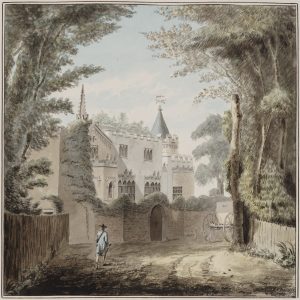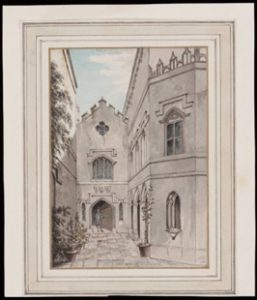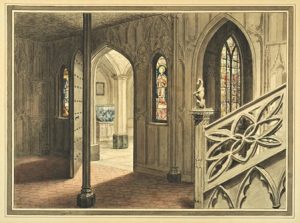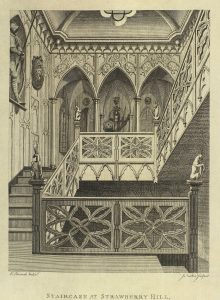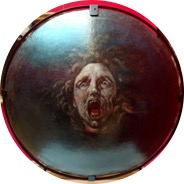We need your support to keep the house open for generations to come. Become a member or donate to our fundraising initiatives today.
Blog: Welcome to Horace’s House
Written by Carole Tucker, Librarian and volunteer guide
7 May 2020
Let me take you back to the 18th century – you are coming to visit Horace Walpole’s renowned Strawberry Hill House. Even before you enter the gateway to his “little Gothic castle”, you begin your journey into the world of this extraordinary creation. The dusty road is lined with trees through which you can glimpse the battlements and towers of the gleaming white house. As you pass through the front gate, you find yourself in an enclosed monastic space. If you are a privileged visitor, your host will be there to greet you and he will be sure to point out the blue and white Chinese tub in the cloister and recount the sad story of Selima, his cat who drowned in the bowl while trying to catch the goldfish which once swam in its depths. Horace will tell you that his friend Thomas Gray, the highly acclaimed poet, wrote an ode describing Selima’s demise. [Paying visitors would be met by Margaret the housekeeper and I will write about her in a later blog].
On one occasion, Horace mischievously recounts how he received some important foreign visitors wearing a wooden cravat carved by Grinling Gibbons and elbow length embroidered gauntlets which had belonged to James I. As he wrote, “the French servants stared, and firmly believed this was the dress of an English country gentleman”.
Once inside the house, the monastic theme gives way to a dark medieval stone hall, but it is a medieval hall in miniature and the carved gothic stone walls quickly reveal themselves to be painted paper – a kind of stage set! Horace sourced the design of the paper from an engraving of Prince Arthur’s chantry tomb in Worcester Cathedral. He was later rather taken aback when he visited Worcester and found that it “is on a less scale than the paper and is not of brass but stone and that wretchedly whitewashed”. Nevertheless, Horace describes the hall and staircase as “the most particular and chief beauty of the castle”. He goes on to write:
… Imagine the walls covered with (I call it paper, but it is really paper painted in perspective to represent) Gothic fretwork: the lightest Gothic balustrade to the staircase, adorned with antelopes (our supporters) bearing shields; lean windows fattened with rich saints in painted glass and a vestibule open with three arches on the landing place, and niches full of trophies of old coats of mail, Indian shields made of rhinoceros’ hides, broadswords, quivers, long bows, arrows and spears—all supposed to be taken by Sir Terry Robsart in the holy wars. [Letter to Horace Mann 12 June 1753]
The hall is small and, of course, not at all like an actual medieval hall but Horace cleverly continues the idea of a medieval space upstairs on the first landing where he located an Armoury. It is the first armoury to be created in a newly built Gothic house in the 18th century and thus it created a great deal of attention. Like the hall downstairs, it is an armoury in miniature and furnished with an eclectic mixture of arms though Horace encouraged the impression that their history was linked to English history. The armoury also sets the scene for the Library which opens from it and displays family heraldry and references to the Wars of the Roses and the Crusades. The importance of the Walpole family history has already been signalled by the carved antelopes (Walpole family heraldic supporters) on the newel posts to the staircase which leads up to the top of the house.
The topmost landing became famous after the publication of “The Castle of Otranto”, Walpole’s seminal Gothic horror novel, inspired by his dream of a gigantic hand in armour reaching over the uppermost banister. The landing is sunlit during the day but at night-time it is dramatically lit by one gothic lantern with a flickering candle casting shadows through the carved wooden balustrades. The gothic effect was enhanced by some later acquisitions for the Armoury – particularly the armour of Francis I of France in a specially constructed niche high up in the wall and glinting in the candlelight. As Horace wrote: “a very little stretch of the imagination will give it all the visionary dignity of the gigantic hand in armour that I dreamt of seeing on the balustrade of the staircase at Otranto. If this is not realizing one’s dreams, I don’t know what is”. He was also given two Renaissance parade shields depicting truly scary looking heads of Perseus and Medusa and claimed that “they will certainly make me dream of another Castle of Otranto…”
Horace Walpole coined the word “serendipity” and as you continue to explore the house, you will see why….!
Next time, we will take a closer look at ‘Horace Walpole’s Curators’
